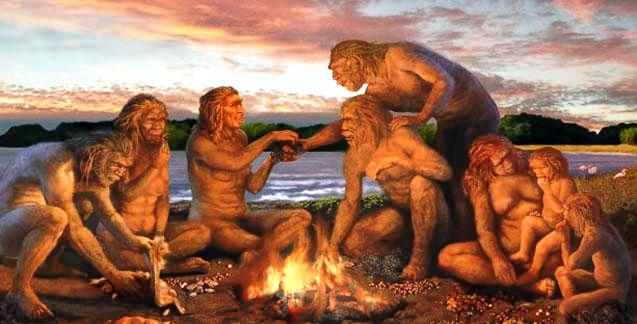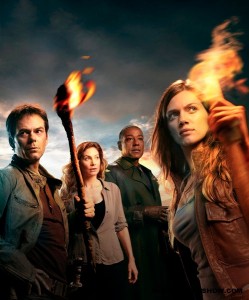 Fire is a fearsome thing. The animal kingdom is confused and fearful of the all consuming entity; horses panic and run toward it, insects are suicidally drawn to it, and most creatures run or fly from deadly flames stricken by terror unmatched by any dreaded predator. About 400,000 years ago, a small ape-like creature changed the world by being the first animal on earth to control fire. An early species of humanoid, Homo erectus, learned to build and manage fire which allowed them to eat cooked food, warm their bodies during cold weather and to ward off predators.
Fire is a fearsome thing. The animal kingdom is confused and fearful of the all consuming entity; horses panic and run toward it, insects are suicidally drawn to it, and most creatures run or fly from deadly flames stricken by terror unmatched by any dreaded predator. About 400,000 years ago, a small ape-like creature changed the world by being the first animal on earth to control fire. An early species of humanoid, Homo erectus, learned to build and manage fire which allowed them to eat cooked food, warm their bodies during cold weather and to ward off predators.
Since then, fire is the essential driving force in all evolution of all things, from animals, machines, and civilization itself. And where fire is not a direct stimulus, all machines run on heat or release heat, from the smallest watch to the infinite apparatus we call the universe. Fire is friendly and formidable; daunting and docile. It is the cause of much of the world’s political upheaval as we drain oil field after oil field to heat our homes, drive our cars, and manufacture fertilizers, plastics and medicine.
We are fascinated by fire as we sit comfortably by a fireplace or wood stove. Economically, fire is very expensive. Everyone knows the sting of costly fire insurance premiums, cities and towns spend billions of dollars for legions of fire fighters and equipment, building codes constantly evolve trying to keep up with new materials and systems to keep fire at bay, and if you do want a fire in your house, it costs thousands of dollars to install furnaces and kitchen equipment designed to safely contain the fire. After that, the money hemorrhage continues for the fuel needed to power the fossil fuel monsters.
And fire can be fun . . . Hollywood fun, that is, where there is never a shortage of explosions, lazy fires, conflagrations and other goodies to keep the audience glued to the tube or flocking to the theater. Try and think of a program or movie that doesn’t show a fire somewhere for effect, from the lowly single match lighting a cigarette or pipe in a romantic scene to the giant explosion engulfing huge amounts of real estate, indeed, sometimes entire worlds. Now Hollywood is dabbing in computer graphics where nerds replace pyrotechnics and its esteemed artists. What fireworks expert ever dreamed he or she would be replaced by a computer?
All the glory and romance aside, fire is a very simple thing. It is merely the rapid oxidation of materials that gives off light, heat, water vapor, carbon dioxide and so on. Think of a piece of metal with rust . . . it’s the same thing, only a lot slower . . . slow oxidation. Just like a fire reduces a pile of wood to ash, the rusting metal, too, someday will be a soft pile of rust particles.
To start a fire burning, three things must be present- first, a source of fuel, say wood, for instance, second, oxygen, and third, a high temperature. The temperature needed to burn wood is its kindling temperature and that runs about 800 degrees Fahrenheit. A fire goes out when 1) it runs out of fuel, or 2) there is no more oxygen, or 3) the temperature is reduced to less than the kindling temperature. Cool it with water, smother it with foam, or remove the burning material and fire is out cold.
So why do torches on television never go out? They defy the elements, gravity and just about every law of thermodynamics. Torches were used throughout the history of movie making and television production, and appear to be the most fuel efficient, brightest, cleanest and safest light available. Never any excess soot, never scorches or burns the user, never hard to light, and keeps going and going like the Energizer Bunny. Harrison Ford in Indiana Jones and the Last Crusade didn’t even need a stick of wood, as he ripped off a femur of a nearby skeleton, wrapped it with some rotted clothing and fired off a leg bone torch, the envy of a Coleman gas lantern. Star Trek’s dungeons and castle prisons were usually lit by wall mounted torches that burned eternal, but the prize for best torches in a dramatic series (the envelope, please!) goes to LOST. Torches on this island beat anything dreamed up by the “Professor” in Gillian’s Island. The hand-held beacons in LOST burned forever without anyone actually wrapping or creating a torch. No fuel was needed and they never went out no matter what the weather- snow, rain, gloom of the night, or if running from the “smoke monster.” And much like Bill Clinton, they really lit up a room. No shadows, fumes, smoke or excessive heat. So heave your incandescent, florescent, and LED bulbs, ’cause there’s a new light in town. Call J.J Abrams and his gang to find out where he’s shopping for his lights, because the Hollywood torches he uses are cheaper than a U.S. Senator in a restaurant. Gives Jerry Lee Lewis something to sing about! Great balls of fire!
about every law of thermodynamics. Torches were used throughout the history of movie making and television production, and appear to be the most fuel efficient, brightest, cleanest and safest light available. Never any excess soot, never scorches or burns the user, never hard to light, and keeps going and going like the Energizer Bunny. Harrison Ford in Indiana Jones and the Last Crusade didn’t even need a stick of wood, as he ripped off a femur of a nearby skeleton, wrapped it with some rotted clothing and fired off a leg bone torch, the envy of a Coleman gas lantern. Star Trek’s dungeons and castle prisons were usually lit by wall mounted torches that burned eternal, but the prize for best torches in a dramatic series (the envelope, please!) goes to LOST. Torches on this island beat anything dreamed up by the “Professor” in Gillian’s Island. The hand-held beacons in LOST burned forever without anyone actually wrapping or creating a torch. No fuel was needed and they never went out no matter what the weather- snow, rain, gloom of the night, or if running from the “smoke monster.” And much like Bill Clinton, they really lit up a room. No shadows, fumes, smoke or excessive heat. So heave your incandescent, florescent, and LED bulbs, ’cause there’s a new light in town. Call J.J Abrams and his gang to find out where he’s shopping for his lights, because the Hollywood torches he uses are cheaper than a U.S. Senator in a restaurant. Gives Jerry Lee Lewis something to sing about! Great balls of fire!
